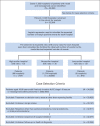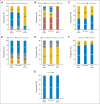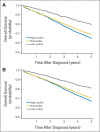Risk-adjusted pathologic margin positivity rate as a quality indicator in rectal cancer surgery
- PMID: 25092785
- PMCID: PMC4162495
- DOI: 10.1200/JCO.2014.55.5334
Risk-adjusted pathologic margin positivity rate as a quality indicator in rectal cancer surgery
Abstract
Purpose: Margin positivity after rectal cancer resection is associated with poorer outcomes. We previously developed an instrument for calculating hospital risk-adjusted margin positivity rate (RAMP) that allows identification of performance-based outliers and may represent a rectal cancer surgery quality metric.
Methods: This was an observational cohort study of patients with rectal cancer within the National Cancer Data Base (2003 to 2005). Hospital performance was categorized as low outlier (better than expected), high outlier (worse than expected), or non-RAMP outlier using standard observed-to-expected methodology. The association between outlier status and overall risk of death at 5 years was evaluated using Cox shared frailty modeling.
Results: Among 32,354 patients with cancer (mean age, 63.8 +/-13.2 years; 56.7% male; 87.3% white) treated at 1,349 hospitals (4.9% high outlier, 0.7% low outlier), 5.6% of patients were treated at high outliers and 3.0% were treated at low outliers. Various structural (academic status and volume), process (pathologic nodal evaluation and neoadjuvant radiation therapy use), and outcome (sphincter preservation, readmission, and 30-day postoperative mortality) measures were significantly associated with outlier status. Five-year overall survival was better at low outliers (79.9%) compared with high outliers (64.9%) and nonoutliers (68.9%; log-rank test, P < .001). Risk of death was lower at low outliers compared with high outliers (hazard ratio [HR], 0.61; 95% CI, 0.50 to 0.75) and nonoutliers (HR, 0.69; 95% CI, 0.57 to 0.83). Risk of death was higher at high outliers compared with nonoutliers (HR, 1.12; 95% CI, 1.03 to 1.23).
Conclusion: Hospital RAMP outlier status is a rectal cancer surgery composite metric that reliably captures hospital quality across all levels of care and could be integrated into existing quality improvement initiatives for hospital performance.
Conflict of interest statement
Authors' disclosures of potential conflicts of interest and author contributions are found at the end of this article.
Figures



Comment in
-
RAMPing up the quality of rectal cancer surgery.J Clin Oncol. 2014 Sep 20;32(27):2938-9. doi: 10.1200/JCO.2014.57.2412. J Clin Oncol. 2014. PMID: 25092784 No abstract available.
-
Surgical margins in rectal cancer-quality measures using the National Cancer Data Base.J Surg Oncol. 2014 Dec;110(8):1023. doi: 10.1002/jso.23807. Epub 2014 Oct 8. J Surg Oncol. 2014. PMID: 25297872 No abstract available.
-
Risk-adjusted pathologic margin positivity rate: a problematic quality indicator.J Clin Oncol. 2015 Apr 20;33(12):1410-1. doi: 10.1200/JCO.2014.58.9234. Epub 2015 Mar 23. J Clin Oncol. 2015. PMID: 25800765 No abstract available.
-
Reply to N.H. Turner et al and Ł. Dziki et al.J Clin Oncol. 2015 Apr 20;33(12):1412-3. doi: 10.1200/JCO.2014.59.9399. Epub 2015 Mar 23. J Clin Oncol. 2015. PMID: 25800769 No abstract available.
-
Do we still need proxies for quality control in rectal cancer surgery?J Clin Oncol. 2015 Apr 20;33(12):1411-2. doi: 10.1200/JCO.2014.58.9622. Epub 2015 Mar 23. J Clin Oncol. 2015. PMID: 25800771 No abstract available.
References
-
- Siegel R, Naishadham D, Jemal A. Cancer statistics, 2012. CA Cancer J Clin. 2012;62:10–29. - PubMed
-
- Wibe A, Rendedal PR, Svensson E, et al. Prognostic significance of the circumferential resection margin following total mesorectal excision for rectal cancer. Br J Surg. 2002;89:327–334. - PubMed
-
- Adam IJ, Mohamdee MO, Martin IG, et al. Role of circumferential margin involvement in the local recurrence of rectal cancer. Lancet. 1994;344:707–711. - PubMed
-
- Marijnen CA, Nagtegaal ID, Kapiteijn E, et al. Radiotherapy does not compensate for positive resection margins in rectal cancer patients: Report of a multicenter randomized trial. Int J Radiat Oncol Biol Phys. 2003;55:1311–1320. - PubMed
Publication types
MeSH terms
Grants and funding
LinkOut - more resources
Full Text Sources
Other Literature Sources

